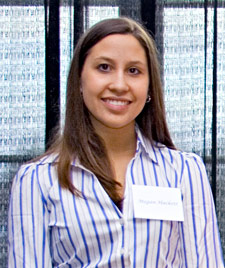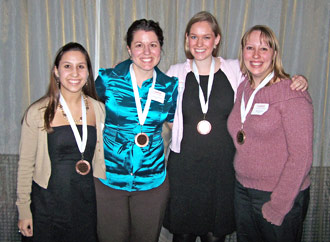
Interprofessional Root Cause Analysis Team Brings Home Third Place from National Case Competition
Colby-Sawyer Nursing student Megan Hackett '10 was part of a four-person interprofessional Root Cause Analysis team that won third place at CLARION's National Case Competition in Minneapolis, Minnesota, in early April.
Healthcare professionals are often extremely specialized and have little awareness of how other practitioners are educated, or how best to work and communicate with them. CLARION is a student-driven committee that creates co-curricular, interprofessional experiences for the University of Minnesota's Academic Health Center and strives to improve patient safety and the quality of care through the promotion and development of inter-professional leadership, teamwork, and communication. The Institute of Medicine estimated in 1999 that up to 98,000 people in America may die each year because of medical errors. With lack of communication a likely and significant cause of medical error, interprofessional education is increasingly emphasized in health care curricula. The case competition brings together interprofessional teams to find the root causes of error in the same hypothetical medical case written for the competition and offer remedies.
This ideal of collaboration was well represented by Hackett's team, which also included Heather Anderson '09 of Dartmouth Medical School; Catherine Machalaba '09, a student of Public Health at The Dartmouth Institute; and Melissa Drye from the Massachusetts College of Pharmacy. Together, they analyzed a pediatric case of a missed diagnosis from the Emergency Department of a fictional hospital, meeting at Dartmouth twice per week where they all had clinical rotations.

“Would you expect a team that never practiced together to win the Superbowl?” asks Assistant Professor and Chair of Nursing Susan Reeves, who invited Hackett to participate in the competition and advised her along the way. “No. And we know that it would be impossible for a relay team that had never practiced a baton pass to win the gold at the Olympics, and we know a symphony would sound pretty lousy if they'd never played together and understood what everyone's piece meant to the whole. So isn't it amazing, then, that we expect health professionals who have never trained or been educated together to magically jump into the practice environment and know how to work together? It's just amazing.”
Colby-Sawyer Nursing students have long participated in case competitions, and this year five juniors competed at the local level against students from Dartmouth and the Massachusetts College of Pharmacy; the local winners came together to form the team that moved on to Minnesota. At the national level, each team was given 20 minutes to present and 10 minutes for questions from the judges. Content counted for 55 percent of the judge's grade; 30 percent depended on style, and 20 percent was based on the team's answers. The team offered a shortened version of their Minnesota presentation at the Susan Colby Colgate Scholars' Symposium on April 22, walking the audience through the hypothetical case of a misdiagnosed three year-old boy that resulted in a $750,000 medical error.
“It was great to meet students from different areas working on the same career paths,” says Hackett, who is a member of the Dean's List, Alpha Chi, president of the Dance Club and listed in Who's Who Among Students in American Universities. “The competition was very professional, but also fun and casual outside of the actual competition. Everyone was very nice.”
Hackett credits her parents, both in the healthcare field, with her interest in nursing and fondness for math and science.
“All the work involved for the competition on top of class work was a challenge, but we learned a lot about common healthcare goals such as providing the best care for the patient,” she says.


